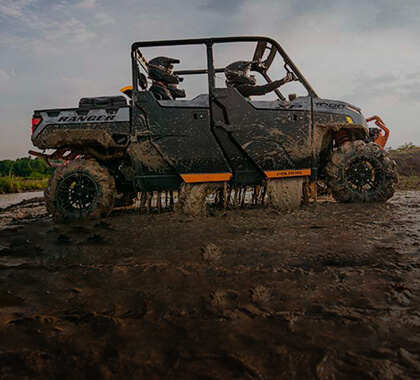Easy Tips and Tricks for Repairing and Replacing Polaris Ranger CV Joints and Boots
Nov 18th 2018
Constant-velocity joints -- also known as CV joints or homokinetic joints -- allow a vehicle to transfer power from the drive shaft to the axles under a wide range of angles and without adding unnecessary friction or movement.
Due to the extreme forces of off-road driving -- and the extreme angles brought about by accessories like Polaris Ranger lift kits and large aftermarket tires -- the CV Joints and boots on Polaris Rangers experience a great deal of stress. Friction, exhaust heat, and the constant pounding of gravity, inertia, and the machine’s sprung weight can cause CV boots and joints to heat up, and over time wear out.

Regardless of the axle brand you have, be it the burly Gorilla Axle or a top-of-the-line Turner Axle, boot damage and CV joint issues are almost inevitable -- especially if you don’t have skid plates and boot guards installed on your rig.
The parts needed to replace a Polaris Ranger boot or CV joint aren’t particularly expensive, but if you take it to a shop or your local dealership to have work done, mechanics could charge you well into the triple digits for labor costs alone.
This is because the tires, brakes, and the CV joints themselves must all be disassembled in order to get anything done. But don’t let this intimidate you. Replacing boots and axle joints can be done at home, and with minimal effort. Using the axles and Polaris Ranger CV Joint assembly kits available at Everything Polaris Ranger, you can change things out quicker and with greater efficiency.
Zooming In On The Polaris Ranger CV Boot
Some people go out of their way to avoid having to replace the CV boots on their Polaris Ranger 700, Polaris Ranger 500, or Polaris Ranger 1000 Utility Terrain Vehicle, going as far as Jerry rigging their front or rear boots with windshield glass sealant to keep them going for as long as humanly possible. While this temporary fix may suffice for the well-prepared UTV McGivers out there, it won’t last long and could lead to further damage to your Polaris Ranger CV joints.
If, for instance, your Polaris Ranger boot tears and you don’t properly repair or replace it, dust, dirt, and small rocks will get inside, scar the CV balls, and wreak havoc on the interior of the joint. If this happens, don’t even bother repairing or replacing your boot, a new axle is what you’ll need.

Many people experience overheating in their axles -- especially with high-performance Rhino and Turner axles -- which causes the boot to tear and even melt in extreme cases. If you’re mechanically inclined and the rear passenger-side boot is the problem area. you can install a heat-shield to block the exhaust heat and keep it from blasting directly onto the boot. You can also get stick stoppers and Polaris Ranger a-arm boot guards to prevent sharp branches and thorny bushes from impaling your CV boots.
Getting A Handle On the Grease
If you buy a new boot, the package should include both grease and clamps. The included grease packet is measured out to be the exact amount needed, so you shouldn’t add any more.
If the kit didn’t come with grease, 880 Crown & Chassis and TRC are the industry leaders in advanced UTV grease for machines like the Polaris Ranger. Take care, however, to not overdo it on the CV joint grease. If you fill the boot too full, it could squirt out around the wheel as you drive, and if you don't fill the boot enough, it won't be properly lubricated.
Although adding excessive amounts of grease to your Polaris Ranger CV boots isn’t a problem by itself, spraying grease around the wheel is a tell-tale sign that you either didn’t tighten the CV boot bands bands enough, or your boot has torn and is thus ejecting grease. So if you put too much grease in there, you won’t know for sure if there’s a problem or not.
As we mentioned earlier, exterior dust and debris can get into the grease of your joints and scar the CV bearings and sockets. But internal spalling from defective or broken parts can also get into the grease and find its way through the boot.
For this reason, you should always clean your joints completely and get rid of the old grease completely. A handy trick to achieve this is to soak your CVs in a coffee can or other container filled with unleaded gasoline. This will help clean it and remove all the old grease and debris. Just make sure to blow it dry with an air compressor before assembly.


